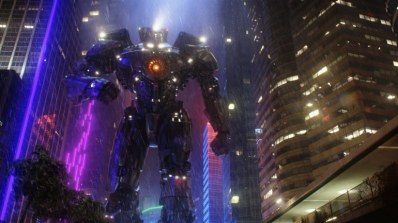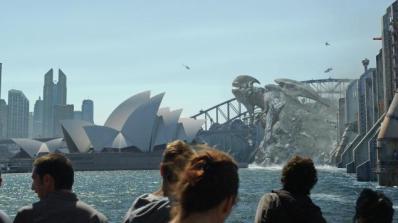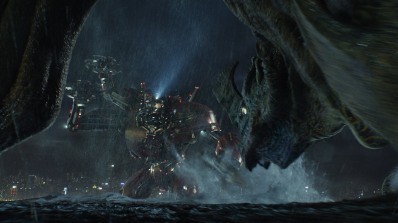 |
| This is all any of us ever really wanted |
Pacific Rim is every inch a movie about robots punching dinosaurs. Yet somehow, director Guillermo del Toro has infused the mecha-Godzilla proceedings with an air of contemporary uniqueness. This is attributed to the fact that Pacific Rim is remarkably well designed, as in his breakthrough film Pan’s Labyrinth. The film is packed to its monstrous gills with show stopping battles and call-backs to genre landmarks.
In near future Earth, mysterious behemoths nicknamed “Kaiju” assault cities bordering the Pacific Ocean. National security takes the form of massive rock-em sock-em robots, or “Jaegers” (German for hunters), affixed with plasma guns and rocket elbows. Maybe this all sounds a little puerile, but Pacific Rim makes it work by taking it all dead seriously. The brain power spent on world building comes through in copious details, like the designs of the Jaegers and Kaijus. Each giant is unique, with nationalistic qualities or novel appendages. Small hints about Pacific Rim’s society prevade, such as the politics that almost shuts the Jaeger program down, and the rockstar treatment of the robot pilots. To del Toro’s credit, all of this is done with amazingly brisk pacing due to clever use of the movie’s premises and rapidly transitioning points of view. For instance, instant pathos is established by the stipulation that the each Jaeger must be operated by a duo connected telepathically by the macGuffin Drift technology.
 |
| I’d probably take my work more seriously if they gave me a cool jumpsuit |
The Drift is used for quick segues into drama, flashbacks, and plot dumps. While it’s not the ideal way to get to know our primary pilots (Charlie Hunnan’s Raleigh and Rinko Kikuchi’s Mako star as crisp action figures), it is an incredibly efficient way to lay out the stakes of the inevitable brawl. This is a necessary compromise for a script servile to action, where each plot beat is a conserved strike. The entire premise and history of Pacific Rim is relayed via narration, skipping right into Empire Strikes Back. The characters are broad clichés that grudgingly cooperate but never change. In some ways this brisk take is refreshing, as little time is wasted on tradition sources of drama like waiting for Idris Elba’s authority figure to relent. It does falter with characterization of course, such as with the ancillary ham team of Charlie Day and Ron Perlman, who are subjected to edits coming so fast both actors have to talk a mile a minute to get basic exposition out the door, ultimately leaving their content unripened. Similar issues like Idris Elba’s health are also handled poorly. So the question is, does the action justify this full tilt style?
 |
| In case of emergency, break Sydney Opera house |
Once the Jaegers are deployed, the movie fires on all pistons. Each battle is uniquely designed, fully exploiting its setting and never retreading ground visited earlier in the film. The roiling sea is both cover and character, hiding the amphibious Kaiju and exploding into spectacular particles as tonnage slams into the surface. On land, the neon lights of the city starkly contrast the diesel machines punching leather reptiles. The composition in Hong Kong is similar to Skyfall’s jellyfish scene but with the buildings soon torn asunder. After scoring a hit, the camera snaps to the clean digital interior and our actors by necessity mimicking (technically originating) the Jaeger’s pose in perfectly clean white jumpsuits. Eye candy is further enhanced by creative armaments like the neon blue plasma cannon, interesting enemy appendages, and the Big One. And when these things go off, spectacular explosions and particles fly everywhere. I think one of the reasons they keep many battles near the shore is to take advantage of the clashing of elements. After a gnarly wound, the Jaeger will belch grimy smoke, sparking fire, and solid debris as the surf continues to pound around it. Finally, del Toro nails the flow of battle. The Jaegers and Kaiju move with a convincing weight and heft (enhanced by great sound work) and seem appropriately dangerous. The creativity and thoughtfulness that went into detailing Pacific Rim comes to fruition here. During one scene, I couldn’t help but grin as it dawned on me why fish were suddenly dropped to the sea bed. It takes a nuanced hand to make action seem fresh and convincing, whether between secret agents or giant robots, and del Toro really raises the bar here. And I say that with knowledge that this is absolutely an arms race. This movie is a moment at the pinnacle of technology. It’s hard to predict if it will still be great a decade from now, but right now, this is the best bang for your buck.
 |
| Does it blend? |
In many ways, the movie industry is moving towards relying on name recognition blockbusters. It’s impressive then, that Pacific Rim swipes in and beats everyone at their own game. It is a weaponized blockbuster structured on its own rules. It is an evolved creature, absolutely aware of the heritage it cribs from. And in an unexpected twist, it doesn’t try to be all things to all people. The generic name is a clue-; the character beats are there but just enough to make the action meaningful. Everything is in service of the kinetic robot pugilism, the roaring neon explosions, and creative last second maneuvers. Sure it’s not Casablanca, but doesn’t that sound like fun?
4/4
**Originally Published on Synthetic Error August 11, 2013
Comments
Post a Comment